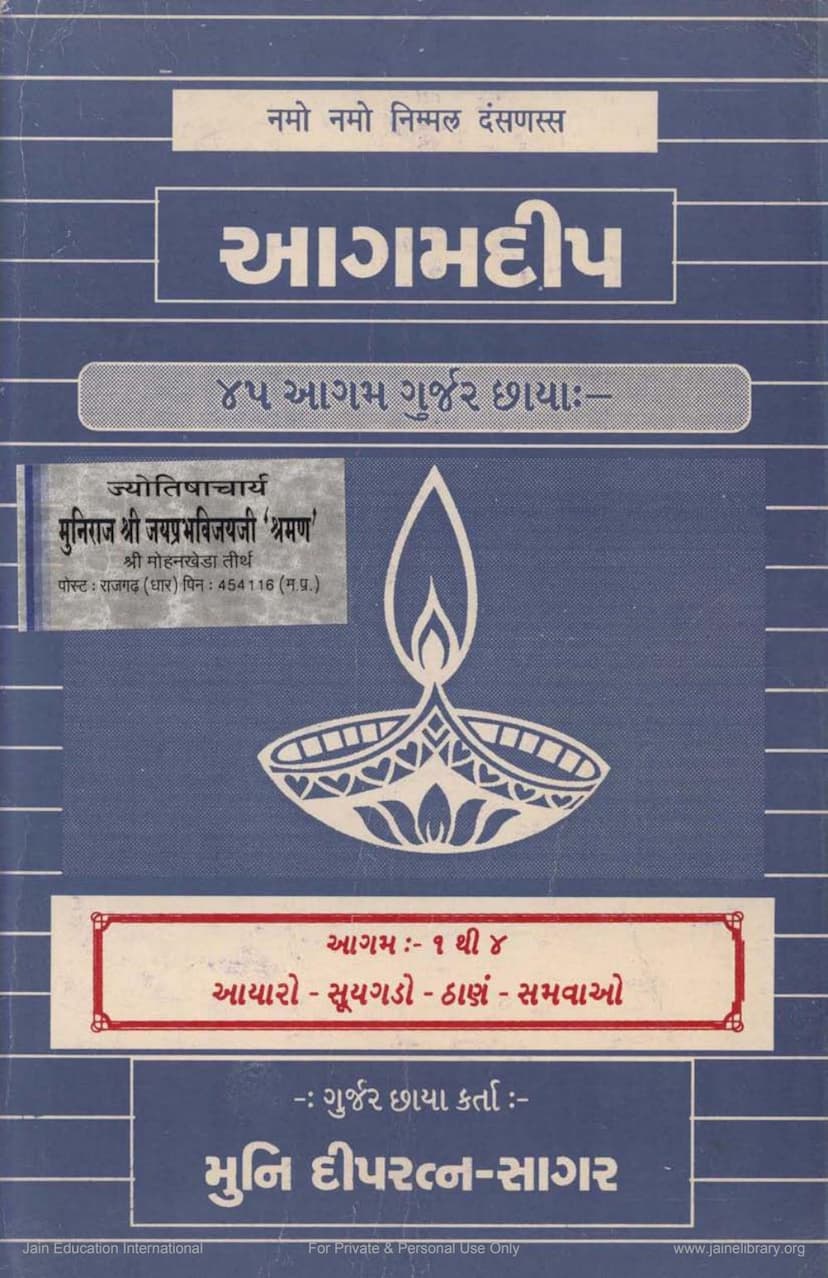Agam Deep 34 Nisihim Gujarati Anuvaad
Added to library: September 1, 2025

Summary
The provided text is a Gujarati translation and commentary titled "Agam Deep 34 Nisih Gujarati Anuvaad" of the Jain text "Nisih" (also known as "Nishitha Sutra"). The work is by Muni Dipratnasagar and published by Agam Shrut Prakashan. This volume is part of a larger series called "Agam Deep."
Here's a comprehensive summary of the content based on the provided pages:
Overall Purpose and Structure:
- Focus on "Nisih" (Nishitha Sutra): The primary goal of this publication is to present the "Nisih" (also referred to as the "first Ched Sutra") within the "Agam Deep" series.
- Gujarati Commentary ("Gurjar Chhaya"): The text offers a detailed explanation and commentary in Gujarati, termed "Gurjar Chhaya," penned by Muni Dipratnasagar.
- Detailed Breakdown of Transgressions and Penances: The core of the book systematically lists various transgressions (doshas or mistakes) that Jain monks and nuns (Sadhus and Sadhvis) might commit. For each transgression, it specifies the corresponding penance (prayaschitta) or disciplinary action required.
- Categorization by "Udeso" (Sections/Chapters): The book is structured into various "Udesos" (sections), each containing a specific range of sutras (verses) detailing particular categories of transgressions and their penances. The provided text covers Udesos 1 through 20, with each Udeso detailing a specific type or severity of transgression.
Key Content and Themes:
- Transgressions and Penances: The bulk of the text is dedicated to outlining specific actions that are considered transgressions for Jain ascetics. These cover a wide range of activities, from improper conduct related to personal hygiene and body care to violations of ascetic rules regarding interactions with the laity, the use of objects, and even thoughts and intentions.
- Types of Penances: The penances are often categorized by their duration or severity, such as "Gudhamasik" (monthly penance), "Laghu Masik" (minor monthly penance), "Guru Masik" (major monthly penance), "Laghu Chaumasi" (minor quarterly penance), "Guru Chaumasi" (major quarterly penance), and others.
- Severity and Intent: The text implies that the severity of the penance can sometimes depend on the intention behind the transgression and the specific circumstances.
- Detailed Listing of Transgressions:
- Udeso 1-5: Focus on physical actions, personal care, improper use of objects, interaction with the laity, and even certain bodily functions. Examples include self-inflicted harm, improper washing, using tools improperly, accepting forbidden items, and improper conduct related to the body.
- Udeso 6-10: Address more complex social interactions, adherence to monastic discipline, acceptance of alms, interactions with other sects, improper speech, and actions related to royalty and religious ceremonies.
- Udeso 11-18: Continue to detail transgressions related to interactions with others, specific types of food and drink, conduct during certain periods (like monsoon), the use of vehicles, and the interpretation and application of Jain scriptures.
- Udeso 19: Focuses on the nuances of penance, including the difference between sincere confession (nishalya) and deceitful confession (mashalya), and how different durations of penance can be modified or extended based on the gravity and repetition of the transgression.
- Udeso 20: Explicitly details the process of confession (alochana) and the determination of penance based on the nature and timing of the transgression and the confession. It outlines how penances can be increased or modified based on the spiritual state of the ascetic.
- Specific Examples of Transgressions and Penances (Illustrative):
- Physical Acts: Improper cleaning of the body, touching or stimulating generative organs, massaging with oils or powders, bathing with specific water, shaving or trimming hair, cleaning ears or teeth improperly.
- Interactions with Others: Accepting food from specific individuals or locations, speaking harshly or falsely, associating with those outside the monastic order, interacting with royalty, seeking patronage.
- Use of Objects: Using bowls, clothes, or tools improperly, mending or modifying them in forbidden ways, requesting new items without necessity.
- Behavioral Transgressions: Laughing loudly, speaking about forbidden topics, accepting teachings from those outside the order, improper sleeping arrangements, traveling in certain seasons or locations.
- Intentional Acts: The text often emphasizes actions done with "intent" or "desire" for sensual pleasure or worldly gain as particularly serious.
- The "Agam Deep" Series and Sponsorship: The publication highlights its place within the "Agam Deep" series, which aims to bring Jain Agamas to a wider audience. It also acknowledges significant financial contributors ("Dravya Sahayak") who made the publication possible, showing a community effort behind its creation.
- Spiritual and Ethical Guidance: The underlying purpose of such a text is to guide ascetics in maintaining their spiritual purity, ethical conduct, and adherence to the strict discipline prescribed in Jainism to achieve liberation.
In essence, "Agam Deep 34 Nisih Gujarati Anuvaad" serves as a comprehensive guide to the ethical and disciplinary rules for Jain monks and nuns, as laid down in the Nisih Sutra. It meticulously details the forbidden actions and the necessary penances, offering a framework for spiritual discipline and purification.